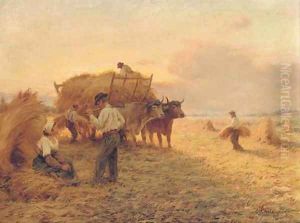Ernest Chateignon Paintings
Ernest Chateignon was a French artist born in 1833 in Tours, France. His work primarily spans the realms of painting and illustration, capturing the essence of French landscape and urban scenery with a detailed and delicate touch. Despite not being as widely recognized as some of his contemporaries, Chateignon made significant contributions to the art world during his time, showcasing a keen eye for the interplay of light and shadow, which brought his landscapes and cityscapes to life in a unique and captivating manner.
Chateignon's artistic journey began at a young age, showing an early aptitude for drawing and painting. He pursued his passion through formal education in the arts, which was a common practice among aspiring artists during the 19th century. Throughout his career, Chateignon remained dedicated to exploring and capturing the beauty of the French countryside, often venturing outside the studio to paint en plein air, a practice that was becoming increasingly popular among artists of his time. This approach allowed him to directly engage with the subject matter, resulting in works that were vibrant, dynamic, and imbued with a sense of immediacy.
The latter half of the 19th century was a period of significant change and innovation in the art world, with movements such as Impressionism and Post-Impressionism challenging traditional artistic conventions. While Chateignon's style remained rooted in a more classical approach, he was undoubtedly influenced by the shifting artistic landscape of his era. His works, characterized by their meticulous detail and subtle use of color, reflect an awareness of these new artistic movements, yet retain a distinctiveness that is uniquely his own.
Ernest Chateignon's contributions to the art world continued until his death in 1908. Although he may not have achieved the same level of fame as some of his peers, his paintings and illustrations remain valued by collectors and art historians for their technical skill and aesthetic beauty. Today, Chateignon's works can be found in various art museums and private collections, serving as a testament to his talent and dedication to capturing the essence of the French landscape.
